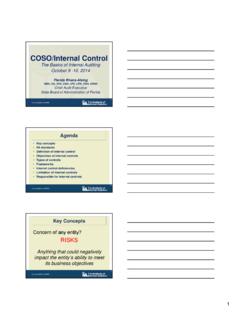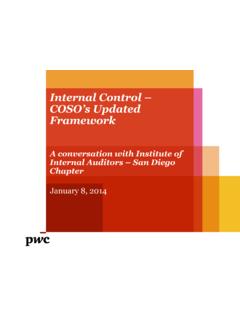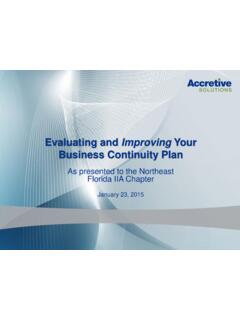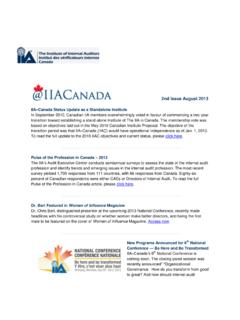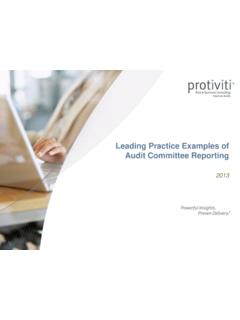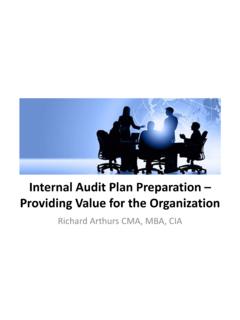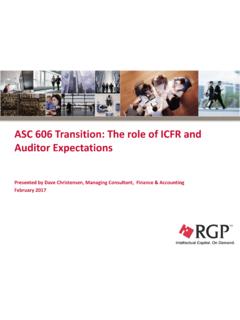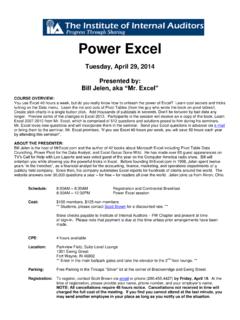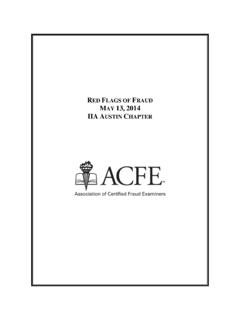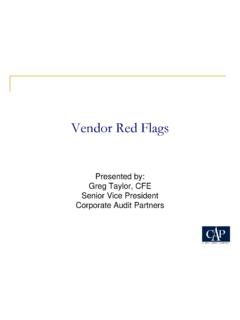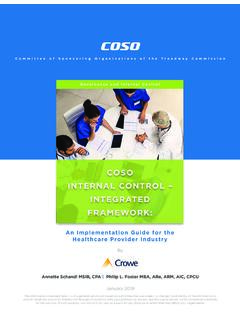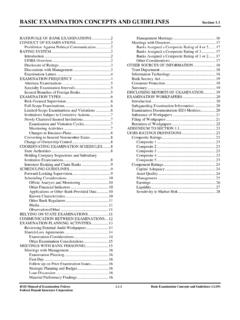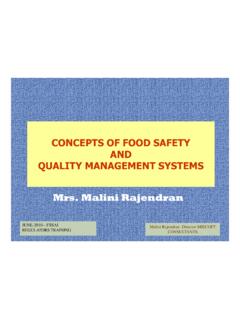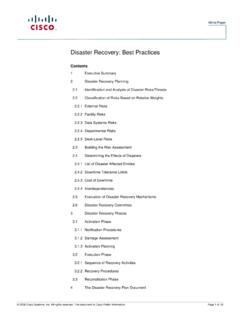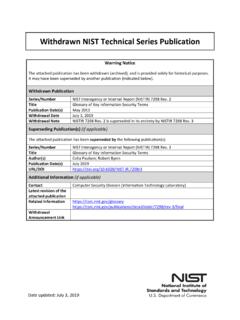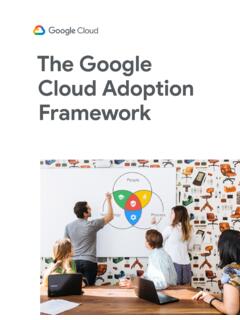Transcription of The Institute of Internal Auditors
1 The Institute of Internal AuditorsPittsburgh ChapterPerspectives on Risk AssessmentFebruary 2013 PresenterNameLevelContact InformationExperienceBrian is a Pittsburgh based Senior Manager within the Financial Services Office of Ernst & Young s Advisory practice. He has over fifteen years of management experience and nine years of experience in the financial services industry serving a variety of clients primarily in the areas of Internal audit compliance andBrian PortmanSenior primarily in the areas of Internal audit, compliance and risk management. Brian leads several Internal audit co-source and outsourcing arrangements, including all aspects of the Internal audit framework - risk assessment, audit planning, audit execution, reporting, issue tracking and Audit Committee reporting.
2 Prior to joining Ernst & Young, Brian worked as a Bank Examiner with the OCC, conducting safety andBank Examiner with the OCC, conducting safety and soundness, compliance and specialty 1 Agenda Introduction Great expectations Key risk assessment concepts Top down risk assessment Bottoms up risk assessment Bottoms up risk assessment Engagement-level risk considerations Continuous monitoring risk considerationsikt Risk assessment process Key takeaways Appendix: Sample matricesPage 2 Great expectationsGreat expectationsInstitute of Internal Auditors 2010 Planning The chief audit executive must establish a risk-based plan to determine the priorities of the Internal audit activity, consistent with the organization s goalsItttiInterpretationThe chief audit executive is responsible for developing a risk-based plan.
3 The chief audit executive takes into account the organization s risk management framework, including using risk appetite levels set by managementfor the different activities or parts of the organization. If a framework does not exist, the chief audit executive uses his/her own g,/judgment of risks after consideration of input from senior management and the board. The chief audit executive must review and adjust the plan, as necessary, in response to changes in the organization s business , risks, operations , programs, systems, and controls. 2010 A1 The Internal audit activity s plan of engagements must be based on a The Internal audit activity s plan of engagements must be based on a documented risk assessment, undertaken at least annually. The input of senior management and the board must be considered in this process.
4 2210 Engagement Objectives ggjObjectives must be established for each Internal Auditors must conduct a preliminary assessment of the risks relevant to the activity under review. Engagement objectives must reflect the results of this assessment Page 4of this assessment. Great expectationsFederal Reserve BoardInternal Audit Risk Assessment Assessments typically analyze the risks inherent in a given business line or process, the mitigating controls processes and the resulting residual risk exposure to the the mitigating controls processes, and the resulting residual risk exposure to the institution Assessment should be well documented and dynamic, reflecting changes to the system of Internal controls, infrastructure, work processes and new/changed business lines or laws and regulations.
5 Risk assessments should consider thematic control issues, risk tolerance, and governance within the institution Assessments may be qualitative and quantitative and include factors such as impact/likelihood of an event occurring. Should be formally documented and supported with written analysis of the risks. Should include specific rationale for the overall auditable entity score A high-level summary of risk assessment results should be provided to the audit committee and include the most significant risks facing the institution, as well as how those risks have been addressed in the audit plan Page 5how those risks have been addressed in the audit plan Great expectationsPerspectives Risk assessment is a process by which an auditor identifies and evaluates the quantityof the organization s risks and the quality of its tl th ik The existence of risk is not the primary reason of concern rather Auditors controls over those risks OCC The existence of risk is not the primary reason of concern.
6 Rather Auditors must determine if the risks are warranted. Generally, risks are warranted if they are understandable, controllable, and within the institution s capacity to withstand adverse performance pFFIEC Risk analysis is intended to provide Auditors with a concise method of Risk analysis is intended to provide Auditors with a concise method of communicating and documenting judgments about the quantity of risk, quality of risk management, and aggregate levels of risk. FFIECPage 6 Great expectationsFundamentalsAll risk-based audit programs should: Identify all of an institution s businesses, product lines, services, and functionsdttht tdlththbdt l Identify the activities and compliance issues within those businesses, product lines, services, and functions that should be audited Include profiles of significant business units, departments, and products that identify business and control risks and document the structure of risk management and business and control risks and document the structure of risk management and Internal control systems.
7 Use a measurement or scoring system to rank and evaluate business and control risks of significant business units, departments, and products Include board or audit committee approval of risk assessments or the aggregate result thereof and annual risk-based audit plans Implement the audit plan through planning, execution, reporting, and follow-up Have systems that monitor risk assessments regularly and update them at least annually for all significant business units, departments, and products Page 7 Key Risk Assessment ConceptsKey risk assessment conceptsRisk hierarchyRisk CategoryFacilitate the identification, measurement and reporting of risk within the business . They are used to help develop a profile of risk within business units of the company. They are the highest classification of risk within the risk of risk within the risk : Reputation Risk, Strategic Risk Operational RiskThe potential that events may have an adverse affect on the earnings.
8 Risks are components within the risk universe where Risk earnings. Risks are components within the risk universe where events may occur. Risks are categorized for ease of measurement and reporting. Examples:Governance: management oversight, policy/proceduresCompliance: legal/regulatory, fraudOperational Risk: systems, MIS, peopleAn event or activity that could lead to the realization of a risk. G Th ik ii f th itt t t t Risk CausesGovernance: The risk arising from the committee structure not being aligned or commensurate with the company s organizational structure and risk profileOperational, people: The risk arising from inadequate staffing levels skills sets or succession planning resulting in ineffective Page 9levels, skills sets, or succession planning resulting in ineffective execution of the strategic plan or day-to-day risk assessment conceptsRisk identification ( what is the risk ) a description of the risk presented Example: Risk of non-compliance with rationale ( why does the risk exist ): - what event(s) cause the risk to occur Example.
9 Risk of non-compliance with regulations due to reports of financial information required by regulatory agencies or tax authorities being incomplete, inaccurate, or ( ht ) th tt t hi h if li d th i k ld ff t th ( so what ) the extent to which, if realized, the risk would affect the Company; may be expressed in qualitative or quantitative terms Considerations: financial effect, reputation impacts, ability to achieve key goals and objectives Example: Risk of non-compliance due to reports of financial information required by lt i t thiti bi ilt it ti l i th regulatory agencies or tax authorities being incomplete, inaccurate, or untimely, exposing the company to fines, penalties and ( how often ) probability of the risk occurring over a defined time frame Consideration: often 1 year; also consider frequency of occurrence Consideration: often 1 year.
10 Also consider frequency of occurrence Example: Risk of non-compliance due to reports of operating and financial information required by regulatory agencies or tax authorities being incomplete, inaccurate, or untimely, exposing the company to fines, penalties and likelihood of occurrence over the course of the quarter is considered to be high based on the volume of global reporting Page 10qggpgrequirementsKey risk assessment conceptsUniversal considerations Should include both quantitative and qualitative considerations Metrics alone are not analysis Auditors need to understand the drivers and impact beyond just the metrics e g what why so what how oftenbeyond just the metrics what, why, so what, how often Need both top-down and bottoms-up assessment aspects Analysis may vary based on the level of assessment being performed Line of business vs Auditable Unit vs EngagementBusiness vs.
